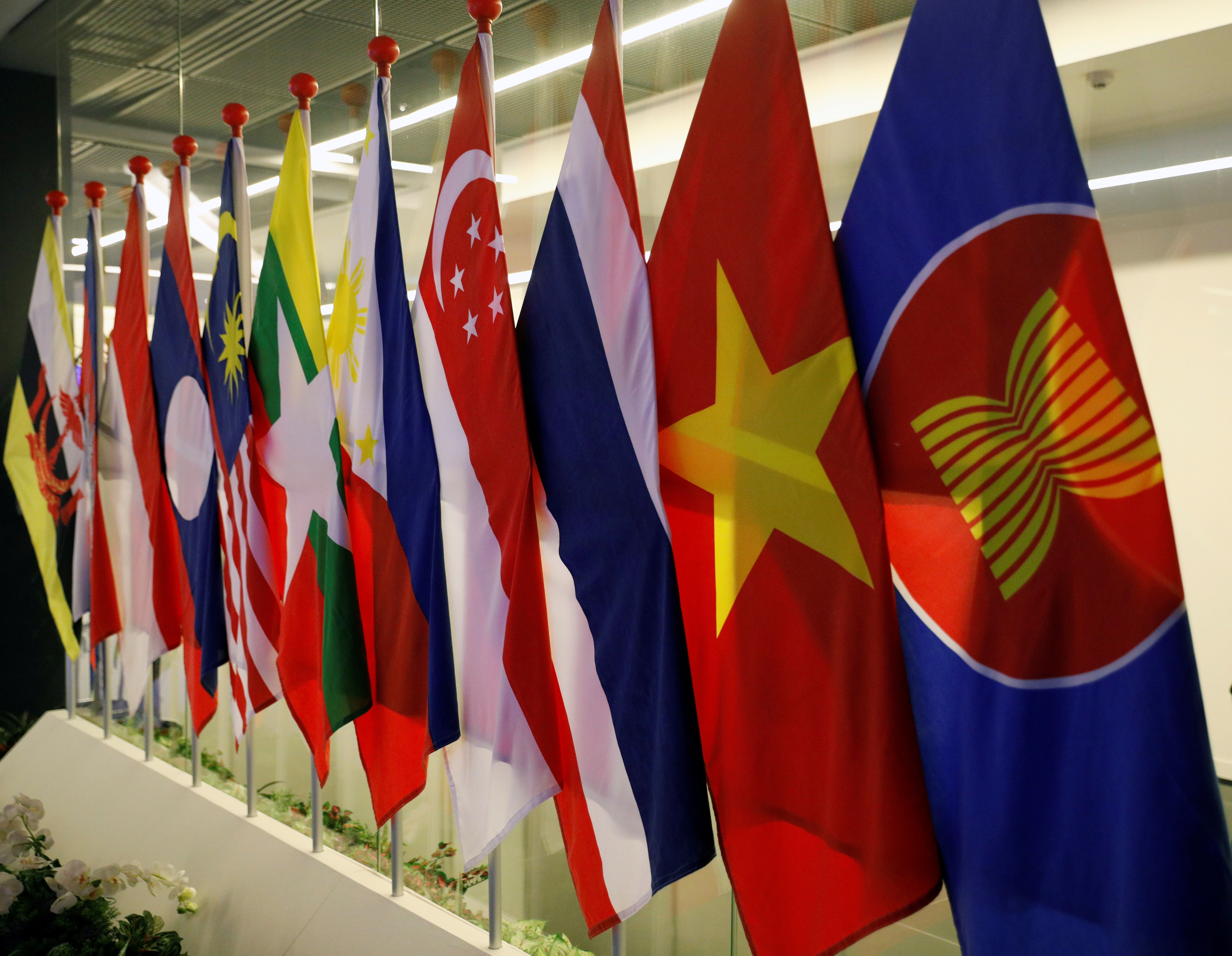South Korea’s Growing Economic Involvement in Southeast Asia

Conditions
The export-oriented nature of South Korea’s economy makes finding new markets a key objective of its foreign policy. Since 2003, it has implemented this strategy by concluding free trade agreements (FTAs), thanks to which it is at the forefront of countries with the most liberalised exchange of goods and services. As of January this year, South Korea had 17 FTAs in force, covering 56 countries. Thus, 73.6% of its exports and 65% of its imports are carried out under FTAs. This translates into its significant position in international trade—in 2019, South Korea was the seventh-largest exporter and ninth-largest importer in the world (including Hong Kong).
In recent years, problems have emerged as a result of the strong dependence of South Korea on major trading partners, mainly China, the U.S. and Japan (see Fig. 1). South Korean trade and investments were weakened by Chinese economic pressure on South Korea after the American THAAD anti-missile system was deployed on its territory in 2017, the U.S.-China trade war, U.S. trade protectionism, trade disputes with Japan, and the economic impact of the pandemic. These problems prompted South Korea to greater diversify its economic ties. This is reflected in the growing economic activity of South Korea in Southeast Asia. ASEAN countries are absorptive and prospective markets, as well as attractive investment locations for South Korean companies, also due to lower labour costs. In addition, for years South Korea has had FTAs with the region—with Singapore since 2006, ASEAN since 2007, and Vietnam since 2015—which facilitates business contacts.
While South Korea initiated a dialogue with ASEAN in 1989, only in recent years has it treated Southeast Asia as one of the main directions of foreign policy. This was reflected in the announcement by the administration of President Moon Jae-in in November 2017 of its New Southern Policy (NSP), which gives greater importance to Southeast Asia and India in foreign relations. South Korea has traditionally focused on Northeast Asia and the U.S., China and Japan. South Korea declares it will seek to deepen relations with ASEAN countries and India on three levels: economic, people-to-people contacts, and regional security. The most important are the economic goals related to the diversification of trade and investments, mainly in Southeast Asia. In November 2020 during the South Korea-ASEAN virtual summit, Moon announced the “NSP Plus” initiative, emphasizing the deepening of ties with Southeast Asia, including healthcare cooperation, in the face of the consequences of the COVID-19 pandemic.
Economic Involvement
Due to South Korea’s seeking out new sales markets and the growing economic potential of Southeast Asian countries, in the 30 years of South Korea’s partnership with ASEAN, their trade increased almost 20-fold, from $8 billion in 1989 to $151 billion in 2019. Especially in the last two decades, South Korea recorded a dynamic increase in trade with ASEAN (see Fig. 2), thanks to which in 2019 its exports amounted to $95.1 billion and imports to $56.2 billion. In effect, ASEAN’s share in South Korean exports increased, which in 2019 amounted to 17.5%, thus strengthening ASEAN’s position as the second-largest market for South Korean goods, after China. The association is also the third-largest source of South Korean imports (11.2% share in 2019), behind China and the U.S. The most important is cooperation with Vietnam, dating back to the 1990s, which developed thanks to its openness to trade and investment (Doi Moi reforms) and the very high popularity of South Korean pop culture in this country. Since 2017, Vietnam has been South Korea’s third-largest export market, accounting for 45.8% of its total trade with ASEAN (see Table 1). Due to the lower economic potential than its main competitors—China, the U.S., the EU, and Japan—South Korea is only ASEAN’s fifth-largest trade partner (see Fig. 4).
The increase in exports to ASEAN countries is related to the growing investments of South Korean companies that import components for their plants in Southeast Asia. In 2019, 14,680 South Korean companies operated in ASEAN countries and the value of foreign direct investment (FDI) inflow amounted to $9.5 billion. FDI stock amounted to $72 billion. Thus, ASEAN was the third-largest destination for South Korean FDI, behind the U.S. ($14.8 billion) and the EU ($13.6 billion), but ahead of China ($5.8 billion). Of its members, Vietnam is the most important (46.8% of South Korean FDI value in ASEAN in 2019) and Singapore (31.7%) (see Fig. 3). South Korean investments mainly concern the manufacturing (39.3% of the value in 2019), financial and insurance (30.7%), and real estate (6.2%) sectors. To support its investment presence in the region, South Korea uses official development assistance (ODA), about 25% of which goes to the countries of Southeast Asia. In 2019, six ASEAN countries were among the 10 largest recipients of South Korean ODA. The aid supports research and development in the countries of the region, including in the field of digitalisation, education, and the development of smart cities, which also improves investment conditions.
South Korea has also signed additional FTAs with the countries of Southeast Asia. The Regional Comprehensive Economic Partnership (RCEP), signed in November last year, gives it the opportunity to increase exports, including automotive and steel industry goods to ASEAN markets and is conducive to locating investments there. In addition, in December 2020, South Korea signed a trade and investment agreement with Indonesia, negotiates agreements with Malaysia, the Philippines, and Cambodia, and plans to update the agreement with ASEAN.
Conclusions and Perspectives
South Korea’s growing economic involvement in Southeast Asia is a key element in the diversification of the country’s trade and investment. This trend also applies to other countries such as Japan, Taiwan, and the U.S., and has been hastened by the COVID-19 pandemic. Although ASEAN countries are increasingly important markets for South Korean exports, China and the U.S. remain the main recipients, which shows the scale of the South’s dependence on these two major economic partners. Many South Korean companies maintain factories in China to have easier access to its absorptive market.
South Korea’s economic engagement with ASEAN is uneven, with a primary focus on Vietnam and Singapore, which have the most favourable business environments. In the face of competition on ASEAN markets, mainly from Japan and China, South Korea is facing the task of increasing its share in regional value chains by expanding the production base in other countries. In this context, it is possible to indicate Indonesia and Cambodia, as well as India, which, however, in the short term are less attractive for investment from South Korea due to poor infrastructure, administrative barriers, and environmental pollution. Outside Southeast Asia, South Korea will look for other sales markets based on new trade agreements. It is currently negotiating 14 agreements, including with Mercosur, Russia, and a trilateral agreement with Japan and China. It also shows initial interest in joining the Comprehensive and Progressive Agreement for Trans-Pacific Partnership as a complement to the RCEP. Thus, South Korea will try to maintain a balance between China and the U.S., not wanting to be unequivocally on either side in their rivalry.
South Korean companies increasingly will be a competitor on the markets of ASEAN countries for investors and exporters from EU countries. Through investments in the countries of Southeast Asia, South Korea can increase the competitiveness of its products, for example, by using the EU FTAs with Vietnam and Singapore. These issues will be taken into account by the EU in FTA negotiations with ASEAN countries, such as Indonesia and the Philippines, and may accelerate under the influence of increasing competition, among others, from South Korea.
Despite the pandemic and higher involvement in other regions, South Korea has increased investment in the EU. This applies in particular to the electric mobility sector, especially in Poland and Hungary, due to the positive experience of investors, the existing base of sub-suppliers, qualified employees, and investment incentives. Taking advantage of South Korea’s continued interest in economic contacts with European partners, the EU may encourage it to update the FTA to bring in e-commerce and green technologies. It is also in the interest of the EU to convince its partner to ratify the basic conventions of the International Labour Organisation and to protect labour rights, to which South Korea committed in the existing FTA.


